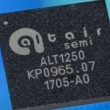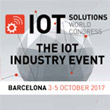

Altair Semiconductor, a provider of LTE chipsets, has introduced the ALT1250, a narrowband CAT-M1 and NB1 (NB-IoT) chipset that aims to redefine the cellular IoT connectivity space, featuring global band support, advanced security and location capabilities far surpassing the functionality of existing chipsets. (more…)
February 16, 2017
Posted by: Avadhoot Patil

According to research carried out by 451 Research, 71% of global businesses are now gathering Internet of Things (IoT) data and 90% expect to increase spending over the next 12 months. (more…)
February 13, 2017
Posted by: Avadhoot Patil

By 2020 it is estimated that the global Internet of Things (IoT) market will have grown to more than $1.7 trillion. According to a study by Gartner, by the end of this year alone the number of IoT devices on the planet will have reached more than 4 billion. (more…)
February 10, 2017
Posted by: Avadhoot Patil

Advantech has launched the WISE-PaaS Marketplace, an online software shopping website that features exclusive software services provided by Advantech and its partners. (more…)
February 7, 2017
Posted by: Avadhoot Patil

Poor IoT device security is a growing concern throughout the business world. Thomas Fischer, Threat researcher and Global Security advocate at Digital Guardian outlines six ways IoT product developers and manufacturers can prevent their devices from being turned into a botnet army. (more…)
February 2, 2017
Posted by: Avadhoot Patil

Event date: October 3 – 5, 2017
Barcelona, Spain
The IoT Solutions World Congress is the leading international event that links the Internet of Things with industry. On its second edition, the event doubled the figures registered on its inaugural one, with 172 exhibiting companies and over 8.000 attendees from 70 countries. (more…)
January 23, 2017
Posted by: IoT global network

It’s difficult to think of a phrase in the past year that brings more of a feeling of dread to an organisation than ‘cyber-attack’. Add the word ‘advanced’ to this and it all seems much more of a hopeless task of trying to defend against it. (more…)
January 19, 2017
Posted by: Avadhoot Patil

As part of the smartphone and smart device revolution, mobile banking has become a popular method for people to manage their finances. The benefits of mobile banking are two-fold: users can bank in a more convenient manner and banks can use smartphones as a way to better engage with their customers. (more…)
Posted by: Avadhoot Patil

Advantech, a provider of embedded computing solutions, has revealed its new comprehensive range of embedded computing platforms with the latest 7th generation Intel® Core™ processor family (formerly Kaby Lake). (more…)
January 16, 2017
Posted by: Avadhoot Patil

HID Global®, a worldwide provider of secure identity solutions, claimed the industry’s first end-to-end identity access management solution that enables government agencies and other organisations requiring higher security to use a single credential for accessing doors, IT systems, networks and data. (more…)
January 10, 2017
Posted by: Avadhoot Patil